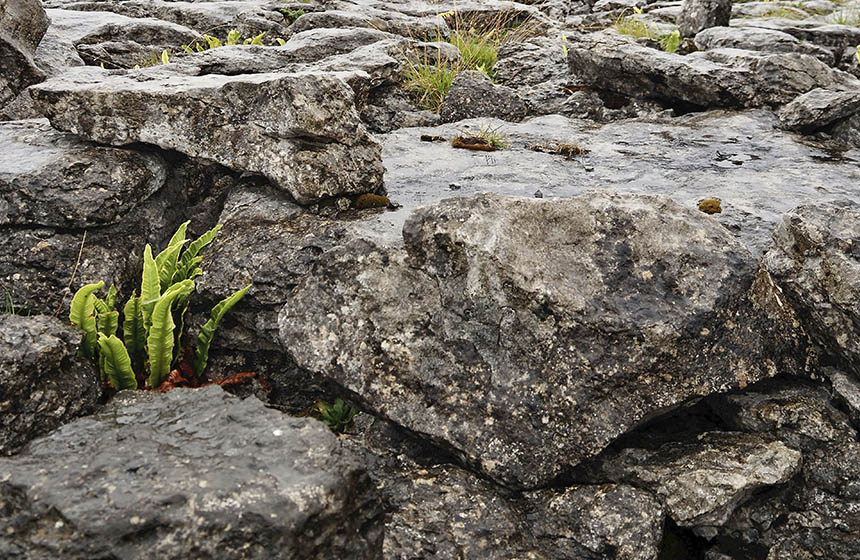Wild Ingleborough: Multi-partnership, landscape-scale habitat restoration
Organisations, charities and local communities have partnered to restore ancient woodland, peatland, hay meadows and facilitate low-intensity farming with objectives to improve biodiversity, increase carbon capture, and improve access for people.
Nature-based intervention:
The Wild Ingleborough project covers 1,200 hectares of land across the Ingleborough National Nature Reserve (1). Nature-based initiatives include blocking blanket bog drainage and planting new woodland areas to increase carbon sequestration, improve water quality and reduce downstream flooding. Farming strategies have been modified to improve ecosystem health, such as by reducing sheep numbers to facilitate habitat diversity. These interventions are shaped in consultation with local community and business partners. In addition, Wild Ingleborough encourages access to nature areas for refugees, people with disabilities and other groups through the ‘Experience Wild Ingleborough’ fund.
Overview of context:
Sheep farming is a longstanding tradition in the Dales. However, the post-Second World War surge in sheep numbers led to habitat degradation and fragmentation (2). Since its launch in 2021, the project seeks to balance traditional commons grazing rights with initiatives to promote nature recovery and tourism.
Case effectiveness on
Climate change
While measurements of carbon sequestration are not reported, it is expected that habitat restoration across the estate will contribute to climate change mitigation (3). In particular, restoring 62 hectares of blanket bog is intended to reduce carbon emissions. Blanket bogs are regarded as a Priority Habitat under the UK Biodiversity Action Plan, and their restoration can provide significant carbon abatement or offset potential (4).
Similarly, while climate adaptation is not explicitly reported, landscape restoration across Ingleborough is likely to improve resilience against climate change impacts. Since the project commenced, 65,700 native trees have been planted. Together with the restoration of peat bogs, this is expected to slow the flow of water through the landscape, reducing flooding in downstream communities and improving water quality. The restoration of broadleaf woodlands has been shown to reduce downstream flooding in other uplands in the UK (5).
Ecosystem health
Ecological effect: Not reportedIngleborough provides habitat for species declining in the UK including curlew, red squirrel, globeflower, juniper, and bird’s-eye primrose. Land management changes are planned to support these species, but comparisons with baselines for biodiversity across the estate have not yet been reported. Visitors to the site post sightings on iNaturalist, providing a record of over 100 species, with bird’s-eye primrose as a top species that was most observed in 2022 and 2023 (6) (7). In addition, plans are in place for the establishment of a montane nursery on site to propagate and plant montane trees, shrubs and flowers.
Socioeconomic outcomes
In addition to recovering biodiversity and reducing flood risk, the project aims to support a thriving local economy based on restorative farming and nature tourism. Wild Ingleborough also specifically aims to increase access to the countryside and connections with nature. This is facilitated through programmes for community members including schools, refugees and people with disabilities. The programme Our Ingleborough documents community memories of the land and their conceptions of the future, published in podcasts, short films and a travelling festival (8).
Governance
Local participation in Governance: ActiveLand owned by Natural England and Yorkshire Wildlife Trust is restored in a collaborative partnership with WWF, University of Leeds, UBoC, and Woodland Trust (1). Community engagement is central to the project, and the six core partners have worked closely with stakeholders from the outset, involving local people, organisations, and businesses in co-design of the initiatives (2). The project works at landscape scale, sharing skills and knowledge with landowners, farmers and communities in neighbouring areas to link existing nature reserves into a connected network.
Finance
The project was funded by Aviva, Beastmaker, Judith and Robert Bellfield, Esmee Fairbairn Foundation, Natural England, Quadrature Climate Foundation, The Schofield Family, The Shears Foundation, United Bank of Carbon, and The Woodland Trust.
Monitoring and evaluation
Monitoring of the project is carried out by UBoC and University of Leeds and through citizen science (9). The growth and survival of planted trees will be monitored as well as changes in stored carbon in vegetation and soils. On iNaturalist, visitors to Ingleborough can document animals and plants present, resulting in sighting summaries for 2022 and 2023 (6) (7).
Trade-offs and limitations
No information yet available on tradeoffs and limitations.
References
- Wild Ingleborough. 2024. Wild Ingleborough. https://www.wildingleborough.com/
- Wild Ingleborough. 2022. Wild Ingleborough Community Conversations. https://www.wwf.org.uk/sites/default/files/2022-08/Wild%20Ingleborough%20Community%20Conversations%20.pdf
- University of Leeds. 2022. Wild Ingleborough – one year on. https://spotlight.leeds.ac.uk/wild-ingleborough/
- Artz et al. 2014. Managing and restoring blanket bog to benefit biodiversity and carbon balance – a scoping study. Scottish Natural heritage Comissioned Report No. 562. https://pureadmin.uhi.ac.uk/ws/portalfiles/portal/1587027/562.pdf
- Monger et al. 2021. The impact of semi-natural broadleaf woodland and pasture on soil properties and flood discharge. Hydrological Processes 36:e14453. https://onlinelibrary.wiley.com/doi/10.1002/hyp.14453
- iNaturalist. 2023. A year in the life of Ingleborough. https://www.inaturalist.org/projects/a-year-in-the-life-of-ingleborough-2023?tab=about
- iNaturalist. 2022. A year in the life of Ingleborough(2022)’s journal. https://www.inaturalist.org/projects/a-year-in-the-life-of-ingleborough-2022/journal
- Our Ingleborough. 2022. Our Ingleborough. https://www.ouringleborough.com/
- UBoC. 2024. Wild Ingleborough Project. https://www.uboc.co.uk/portfolio/wild-ingleborough-project/

Intervention type
- Created habitats
- Protection
- Restoration
Conducted at landscape scale
Ecosystem type
- Temperate forests
- Temperate grasslands
- Peatland
Climate change impacts addressed
- Freshwater flooding
Outcomes
- Food security: Not reported
- Water security: Not reported
- Health: Not reported
- Local economics: Not reported
- Livelihoods/goods/basic needs: Not reported
- Energy security: Not reported
- Disaster risk reduction: Not reported
- Rights/empowerment/equality: Positive
- Recreation: Positive
- Education: Positive
- Conflict and security: Not reported
- No. developmental outcomes reported: 3
Resources
Read resource 1Read resource 2
Literature info
- Grey literature




